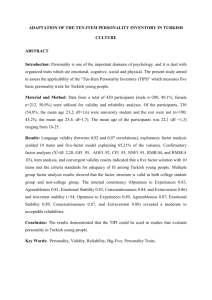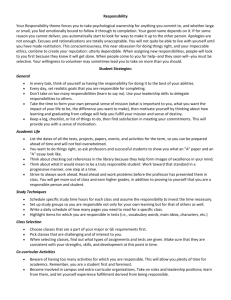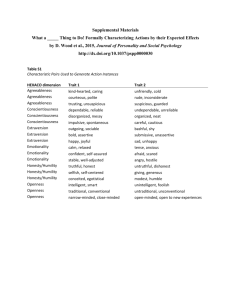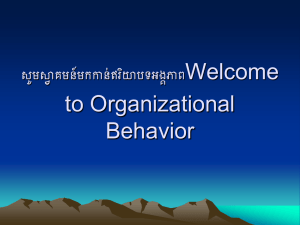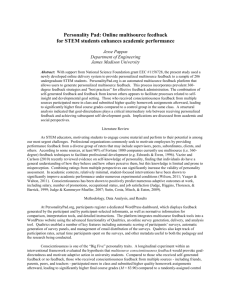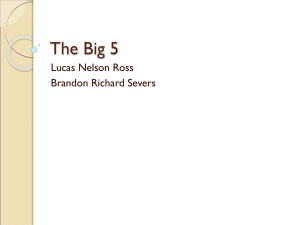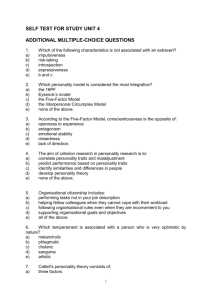Roberts et al 2005
advertisement
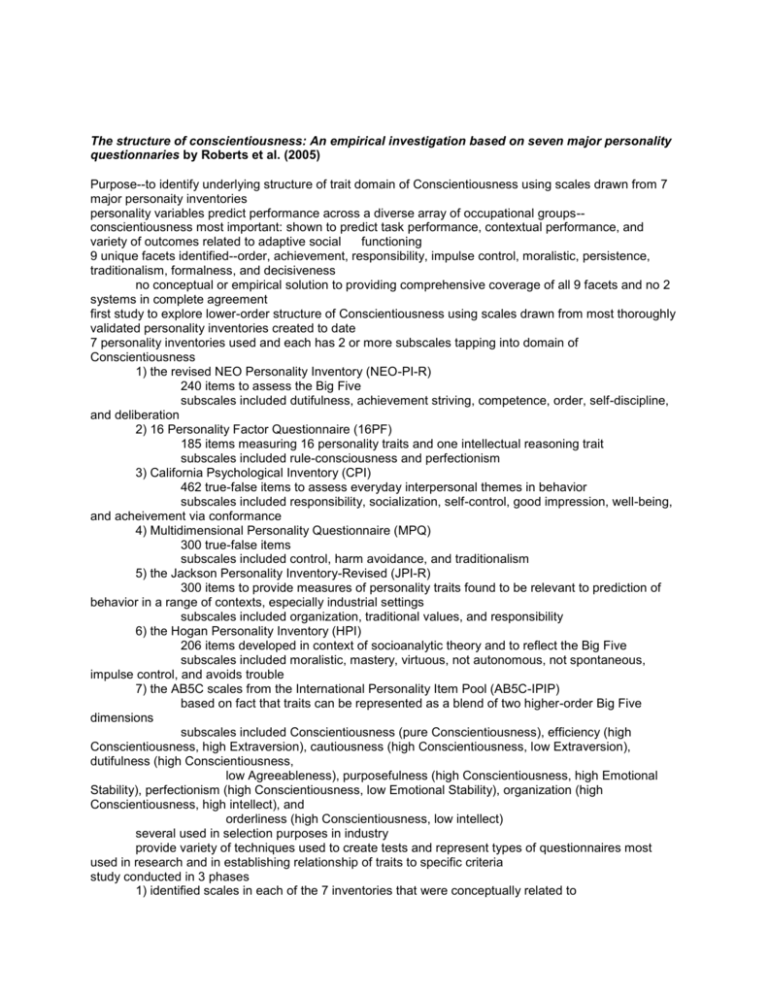
The structure of conscientiousness: An empirical investigation based on seven major personality questionnaries by Roberts et al. (2005) Purpose--to identify underlying structure of trait domain of Conscientiousness using scales drawn from 7 major personaity inventories personality variables predict performance across a diverse array of occupational groups-conscientiousness most important: shown to predict task performance, contextual performance, and variety of outcomes related to adaptive social functioning 9 unique facets identified--order, achievement, responsibility, impulse control, moralistic, persistence, traditionalism, formalness, and decisiveness no conceptual or empirical solution to providing comprehensive coverage of all 9 facets and no 2 systems in complete agreement first study to explore lower-order structure of Conscientiousness using scales drawn from most thoroughly validated personality inventories created to date 7 personality inventories used and each has 2 or more subscales tapping into domain of Conscientiousness 1) the revised NEO Personality Inventory (NEO-PI-R) 240 items to assess the Big Five subscales included dutifulness, achievement striving, competence, order, self-discipline, and deliberation 2) 16 Personality Factor Questionnaire (16PF) 185 items measuring 16 personality traits and one intellectual reasoning trait subscales included rule-consciousness and perfectionism 3) California Psychological Inventory (CPI) 462 true-false items to assess everyday interpersonal themes in behavior subscales included responsibility, socialization, self-control, good impression, well-being, and acheivement via conformance 4) Multidimensional Personality Questionnaire (MPQ) 300 true-false items subscales included control, harm avoidance, and traditionalism 5) the Jackson Personality Inventory-Revised (JPI-R) 300 items to provide measures of personality traits found to be relevant to prediction of behavior in a range of contexts, especially industrial settings subscales included organization, traditional values, and responsibility 6) the Hogan Personality Inventory (HPI) 206 items developed in context of socioanalytic theory and to reflect the Big Five subscales included moralistic, mastery, virtuous, not autonomous, not spontaneous, impulse control, and avoids trouble 7) the AB5C scales from the International Personality Item Pool (AB5C-IPIP) based on fact that traits can be represented as a blend of two higher-order Big Five dimensions subscales included Conscientiousness (pure Conscientiousness), efficiency (high Conscientiousness, high Extraversion), cautiousness (high Conscientiousness, low Extraversion), dutifulness (high Conscientiousness, low Agreeableness), purposefulness (high Conscientiousness, high Emotional Stability), perfectionism (high Conscientiousness, low Emotional Stability), organization (high Conscientiousness, high intellect), and orderliness (high Conscientiousness, low intellect) several used in selection purposes in industry provide variety of techniques used to create tests and represent types of questionnaires most used in research and in establishing relationship of traits to specific criteria study conducted in 3 phases 1) identified scales in each of the 7 inventories that were conceptually related to Conscientiousness domain 2) derived lower-order structure of Conscientiousness by factor analyzing scale scores for individuals who completed all 7inventories exploratory factor analysis used because # of plausible alternative models (how many lower-order Conscientiousness factors exist or which personality scales they influence) is so high that confirmatory factor analyses infeasible and also exploratory factor analysis useful for probing underlying structure of data and generating hypotheses that can be subjected to more rigorous subsequent testing six factors found to be most empirically and conceptually satisfying: industriousness, order, self-control, traditionalism, responsibility, and virtue 3) confirmatory factor analysis used to examine convergent and discriminant validities of resulting lower-order Conscientiousness facets with global measures of the Big Five 737 participants, ages 22-90, completed seven personality inventories over 5-year span and the inventory of 400 behavioral acts and measures of health practices criterion-related validity limited to 197 participants who were working while completing surveys Results six factors showed good convergent validity (high correlations with global Conscientiousness factor) and demonstrated adequate discriminant validity (low correlations with other Big Five) lower-order facets have differential relationships with criteria (i.e. drug use, work dedication, preventative health behaviors, and traffic risk), thus improved criterion-related validity over the broad measure of Conscientiousness no Discussion existing personality test provides systematic coverage of total Conscientiousness domain two factors previously identified not found in this study: decisiveness (identified by lexical research) and persistence (Hough & Ones, 2001)--more research needed to reconcile discrepancies discriminant validity problematic and should view following facets as "interstitial" or "transition" dimensions of Conscientiousness facets of Conscientiousness such as responsibility and virtue strongly correlated with Agreeableness and Emotional Stability high correlation between traditionalism and Openness to Experience criterion-related validity showed not all outcomes were related to job performance (expect work dedication) varied patterns of predictive validity of the six facets across four criteria one or two facets constituted the best predictors of each outcome showing individual facets better predictors of criteria than overall Conscientiousness composite Limitations not all personality inventories assessed factor structure and criterion-related validity based on self-reports, thus socially desirable responses possibly influenced factor structure and patterns of correlations with external criteria--counter in future studies by identifying similar facets and correlates in alternatives methods, such as observer ratings or test data, and in different samples, such as job applicants predictor and criterion data came from same source (self) and that could lead to common method variance and thus somewhat inflated criterion validities lack of multidimensional job performance criteria to evaluate differential validity of the six factors Future Directions more precise knowledge about each facet of Conscientiousness can affect important work outcomes facets have better predictive validity than global Big Five there are moderate intercorrelations between facets--be cautious in interpreting what the average global Conscientious scores really mean Conclusion results can be used to refine meta-analytic categorizations of personality measures in an effort to determine aspects of Conscientiousness that are most related to outcomes such as task and contextual performance the six facets of Conscientiousness found to be heterogeneous--relationships with I/O related criterion variables may be very different and provide incremental validity beyond general factor of Conscientiousness
